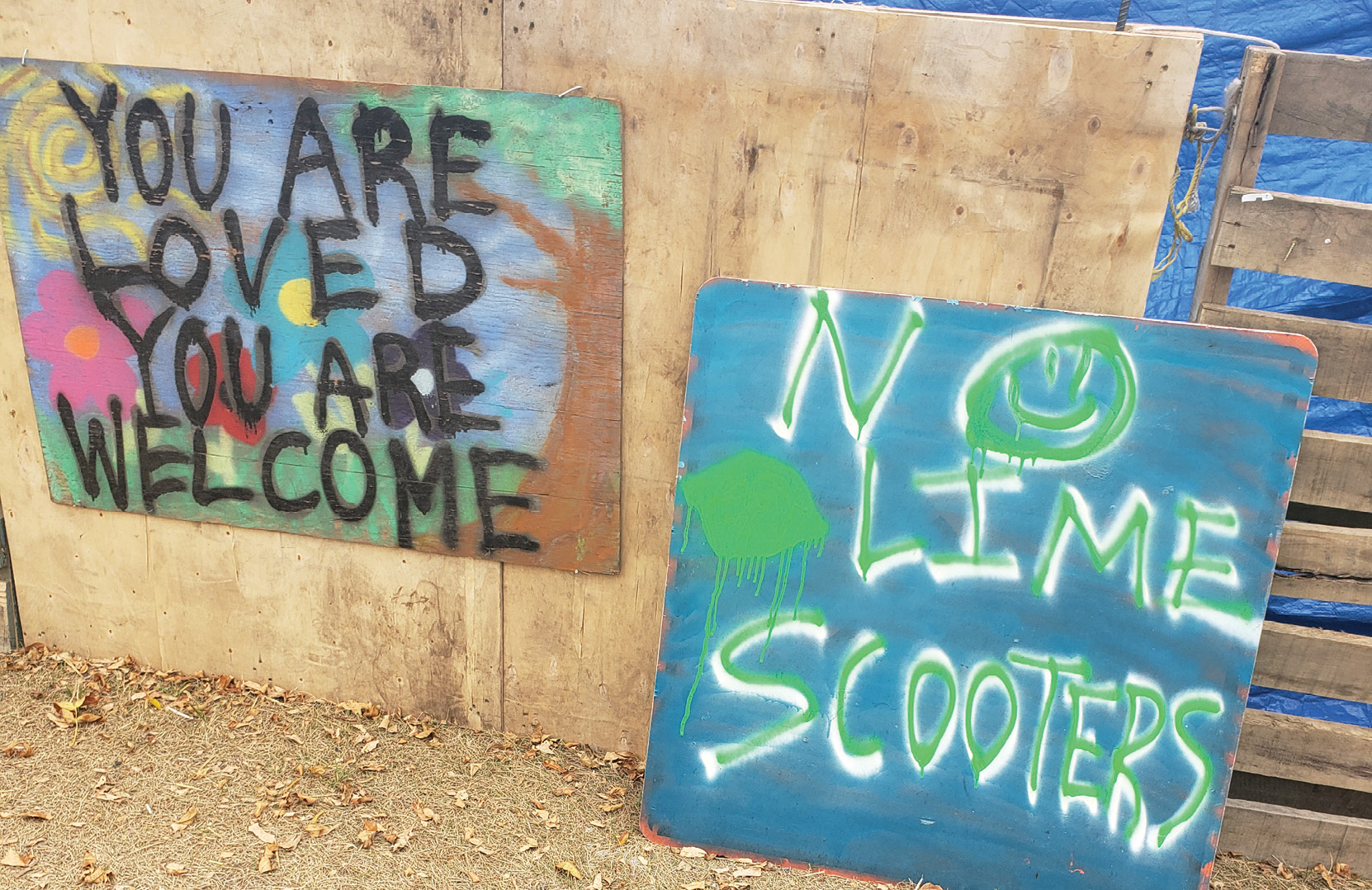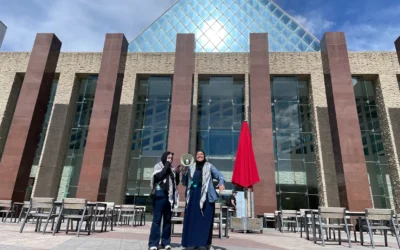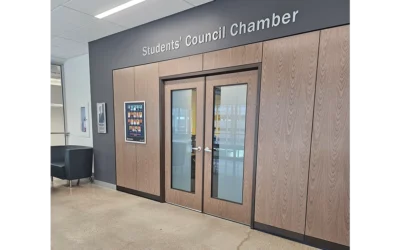Roughly 2,000 Edmontonians are currently homeless, according to an online media release from Mayor Don Iveson on Oct. 10. In the same media release, City Council said that due to the COVID-19 pandemic, this number has been growing in Edmonton. Yet, the maximum capacity of people allowed into shelters has decreased to prevent the spread of the virus. So, where are the growing number of homeless people supposed to go?
Presently, many of the people who are homeless have been staying in the “tent cities,” such as Camp Pekiwewin, which has been providing people without homes a safer place to pitch their tents, with meals, harm reduction services, and a voice to speak out for them. This camp is run by volunteers and organizers who are protesting the lack of government help for Edmonton’s homeless population. One of their main demands of the government is free transit for homeless individuals, so they can make it to hot meal programs, shelters, and appointments.
“The main power behind this camp is its visibility. People drive past the camp every day on their way to work and on their way home. A lot of people didn’t realize the state (the homeless) live in because all of these people have been sleeping rough in places like the river valley, which puts them out of sight and out of mind,” said a volunteer at Camp Pekiwewin who requested to remain anonymous.
The visibility tactic of Camp Pekiwewin has yielded results from the City Council. In response to it and the homeless camps cropping up around Edmonton, Mayor Don Iveson pledged to end homelessness by the end of October. He is promising to give Edmonton’s 2,000 homeless a 24/7 accommodation over the winter.
“This 24/7 element is key because it gives residents a place to self-isolate — normally shelters ask that folks leave in the morning. This site also gives us the space to allow for proper distancing for both daytime and overnight operations,” stated Mayor Iveson in his online media release.
City Council has chosen to use the Edmonton Convention Centre to try to fulfill this promise, according to the media release. The convention centre will be able to accommodate 300 people overnight and 400 people during the day. The 144,000 square feet of the Edmonton Convention Centre means there will be adequate room for the people utilizing the services to social distance properly, but less space than the similar pandemic accommodation that opened during spring.
Earlier this year, the Edmonton EXPO Centre was being utilized for pandemic shelter purposes between March and July. With 522,000 square feet, it was a significantly larger space than the Edmonton Convention Centre but still only accommodated 300 to 400 people at a time. Due to the expenses on the City to maintain and upkeep the building, they decided in July to shut the centre’s doors. This decision left the homeless with no back-up to the services offered at the EXPO Centre for nearly four months.
Volunteers and residents of the Pekiwewin homeless camp are skeptical of Mayor Iveson’s plan to end homelessness and of the Edmonton Convention Centre opening its doors because the previous pandemic shelter closed its doors to people in need so suddenly.
“People are definitely wary. We would love for Don Iveson to end homelessness, and we would fully support that plan, but I don’t see how a temporary shelter is going to end homelessness other than the need for a couple of months. It does not seem like a very sustainable plan,” said the Camp Pekiwewin volunteer.
“We have just continued to operate as if he never came up with the statement to end homelessness. We just continue meeting the needs of camp members where they’re at – providing harm reduction services, meals and prayer release for the campers.”
In Mayor Iveson’s online media release, he acknowledged the City’s failed 10-year plan to end homelessness. Iveson stated that the project is now in its 11th year and attempts to get other levels of government to invest in Housing First projects have had mixed results. As a result, Mayor Iveson switched gears to what he calls an “ambitious” 10-week plan to end homelessness.
“It’s not a shelter in a traditional sense of when the sun comes up you get sent back out on the streets to fend for yourself, it will be actually a place to live, and our longer-term goal is to work with the federal government to make sure that the roots are in place over the next six months to discharge people from the pandemic accommodation into their own housing unit,” said Mayor Iveson in a 630 CHED interview on Oct. 7.
The next step of the City council’s plan includes bridge housing. This temporary housing gives applicants their own private accommodations while they wait for their permanent placement. Currently, the city is using the Coliseum Inn as bridge housing.
“We’re working to get more of this type of housing ready and are using the federal government’s recently announced $1 billion investment in the Rapid Housing Initiative and $236.7 million for the Reaching Home program to get more bridge housing units online,” said Mayor Iveson in his online media release.
Securing permanent housing for homeless Edmontonians is the City council’s final step in its three-part plan. Mayor Iveson has stated that this will take time to advocate for more funding from the provincial government.
“Ending homelessness will require a collaborative effort. The City cannot do it alone — housing and homelessness are jurisdictions of the federal and provincial governments, which is why we’re working so hard to advocate for their involvement. For Edmonton’s plan to be a success, we need the province to commit to ensuring on-site health and social support services in our bridge and permanent supportive housing units, and we need them to offset the cost of rent supplements,” stated Mayor Iveson in his online media release.
“While we are not giving everyone permanent accommodations right away, this will still take some time and further resource commitments from seniority in the government. We are in a position now to say that we will provide vulnerable Edmontonians with a warm, safe and dignified place with embedded supports for complex health challenges and access to pathways that will ensure that they are ultimately housed permanently,” said Mayor Iveson in a press release on Oct. 5.
With the Edmonton Convention Centre opening, 300 out of Edmonton’s 2,000 homeless will have a warm place to sleep overnight. Having a day shelter in place where a maximum of 400 homeless Edmontonians can get out of the cold is certainly beneficial. Mayor Iveson has promoted his plan to end homelessness by now, however, opening a 24/7 shelter that holds a maximum of 400 people will not accommodate all of the 2,000 Edmontonians living on the streets.
Mayor Iveson’s plan will have the benefits of relieving other shelters of COVID-19 capacity limits, but these shelters are not 24/7 and the people who use them will be put back onto the streets during the cold winter days. Capacity limits and hygiene concerns due to COVID-19 in public spaces, such as libraries, that homeless Edmontonians could previously use to escape the cold, may mean there will be limited shelter in the cold winter days ahead for the other 1,600 Edmontonians who are unable to use the 24/7 shelter.





0 Comments